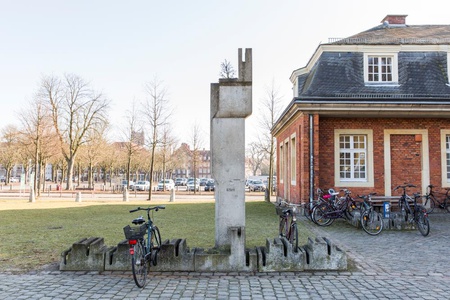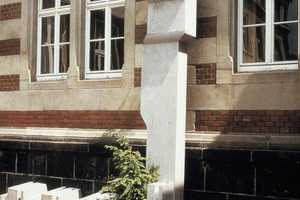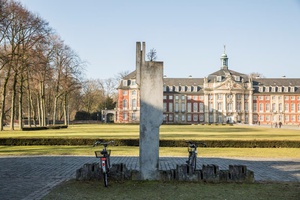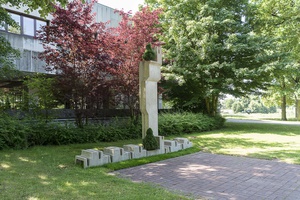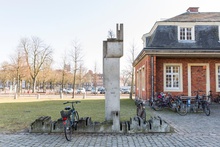Richard Artschwager
Ohne Titel (Fahrradständermonument B) [Untitled (Bicycle Rack Monument B)]
1987
Concrete sculpture and planting
Cast element: 3.82 x 0.75 x 0.5 m
5 prefabricated elements (bicycle racks), each 0.5 x 0.75 x 0.5 m
Location
Originally in the inner courtyard of the so-called Bispinghof, Münster University, Institut für Erziehungswissenschaft [Education Institute]; since 1997 in front of the building at Schlossplatz 1, Münster University AStA [General Students’ Committee], permanent installation
As part of the sculptural exchange between Marl and Münster the work was placed in Marl during Skulptur Projekte 2017.
Owner
LWL-Museum für Kunst und Kultur, Münster
Richard Artschwager
* 1923 in Washington D.C., USA
† 2013 in Albany, USA
For Skulptur Projekte in Münster 1987 Richard Artschwager installed two bicycle rack monuments. One has been preserved, even if no longer in its original location. Since 1997 five concrete bicycle rack structures have been located in front of the guard hut on the south side of Schlossplatz, typical of the kind found throughout the city in the 1980s. They were an ineffective attempt by the city authorities to bring some kind of order to bicycles being chaotically left everywhere. Artschwager added a further element to the row of racks, from which a vertical growth – he spoke of a “metastasis”1 – extended to a height of almost three metres. Since the 1960s the artist has repeatedly worked with objects that both formally and in terms of content could be located somewhere between furniture and works of art, reconstituted everyday objects, which despite their exaggerated form have lost none of their practical use: a form of readymade typical of his work.2
The project the artist presented in Münster in 1987 was his first for public space; it could be considered as an ironic contribution to discussion around the significance of art in urban spaces, as in the 1970s and 1980s it was not only in Münster that concrete was the design element of choice in enhancing public squares. In many places plant containers and their low maintenance plants were employed to camouflage a lack of imagination in urban planning. The condition of the containers was an unmistakable indication of how much attention the municipality and local inhabitants were prepared to dedicate to a square. The plants were only able to survive the dry summer months by diligent watering. Consequently such urban dressing frequently looked appropriately sad after only a few years.
Plants have also grown from both the bottom and top of Artschwager’s bicycle rack “metastasis”, giving the impression that the urban furniture of a typical city centre square has been compressed to just a few square metres. What today is a solitary column on Schlossplatz inserted itself between two windows at its original location in front of a wall in Bispinghof. Here too the question arose of how the small tree, sticking out of the top of the column could be kept alive. It was a problem that Artschwager apparently found amusing: He proposed a complicated and unrealisable watering system.3 The tree did not survive the year, neither did his pendant at the foot of the column or any of the further small trees that have been newly planted.
Eckhard Kluth
1 Klaus Bußmann and Kasper König (eds.), Skulptur Projekte in Münster 1987, exhib. cat.: Westfälisches Landesmuseum für Kunst und Kulturgeschichte, Münster, Cologne 1987, p. 36.
2 Kasper König, Forty Years of Richard Artschwager – Continuities and Discontinuities, Laudatio for Richard Artschwager on the Occasion of the Award of the Roswitha Haftmann Prize, 2007, available online at www.roswithahaftmann-foundation.com/en/prizewinners/2007_laudatio_ra.htm [21.04.2016].
3 Bußmann/König 1987, p. 36.
Images
Location
- Still existing / Public Collection
- Removed
- In the museum
